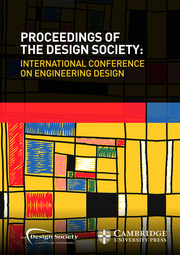Article contents
Towards Holistic Energy-Efficient Vehicle Product System Design: The Case for a Penalized Continuous End-of-Life Model in the Life Cycle Energy Optimisation Methodology
Published online by Cambridge University Press: 26 July 2019
Abstract
The Life Cycle Energy Optimisation (LCEO) methodology aims at finding a design solution that uses a minimum amount of cumulative energy demand over the different phases of the vehicle's life cycle, while complying with a set of functional constraints. This effectively balances trade-offs, and therewith avoids sub-optimal shifting between the energy demand for the cradle-to-production of materials, operation of the vehicle, and end-of-life phases. The present work describes the extension of the LCEO methodology to perform holistic product system optimisation. The constrained design of an automotive component and the design of a subset of the processes which are applied to it during its life cycle are simultaneously optimised to achieve a minimal product system life cycle energy. A subset of the processes of the end-of-life phase of a vehicle's roof are modeled through a continuous formulation. The roof is modeled as a sandwich structure with its design variables being the material compositions and the thicknesses of the different layers. The results show the applicability of the LCEO methodology to product system design and the use of penalization to ensure solution feasibility.
Keywords
- Type
- Article
- Information
- Proceedings of the Design Society: International Conference on Engineering Design , Volume 1 , Issue 1 , July 2019 , pp. 2901 - 2910
- Creative Commons
- This is an Open Access article, distributed under the terms of the Creative Commons Attribution-NonCommercial-NoDerivatives licence (http://creativecommons.org/licenses/by-nc-nd/4.0/), which permits non-commercial re-use, distribution, and reproduction in any medium, provided the original work is unaltered and is properly cited. The written permission of Cambridge University Press must be obtained for commercial re-use or in order to create a derivative work.
- Copyright
- © The Author(s) 2019
References
- 1
- Cited by


